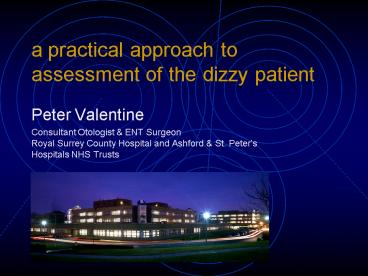a practical approach to assessment of the dizzy patient - PowerPoint PPT Presentation
1 / 35
Title:
a practical approach to assessment of the dizzy patient
Description:
progressive disequilibrium of ageing. aged patient brought in by adult children ... exercise gait training. stick or frame. cervical vertigo : risk factors ... – PowerPoint PPT presentation
Number of Views:2122
Avg rating:3.0/5.0
Title: a practical approach to assessment of the dizzy patient
1
a practical approach to assessment of the dizzy
patient
- Peter Valentine
- Consultant Otologist ENT SurgeonRoyal Surrey
County Hospital and Ashford St. Peters
Hospitals NHS Trusts
2
practical assessment
- easy mainly based on the history
- effective diagnostic groups for investigation
treatment
3
flavours of dizziness
- near syncope
- disequilibrium gait only or global
- true vertigo
- psychogenic
4
trajectory of dizziness over time
SYMPTOM SEVERITY
TIME
5
dizziness associated with commonly used drugs
6
diagnostic matrix for acute vertigo
VERTIGO
EPISODIC
PERSISTENT
HEARING LOSS
Kentala Rauch, 2003
7
diagnostic matrix for acute vertigo
VERTIGO
EPISODIC
PERSISTENT
HEARING LOSS
BPPV
8
benign paroxysmal positional vertigo
- most common type of vertigo seen
- causes
- closed head injury
- vestibular neuritis 20 will develop BPPV
- ear surgery
- prolonged bed rest
9
history key features
- vertigo
- sudden attacks triggered by movement
- last less than 30 seconds
- occur in spells
- time of day, sleeping habits
- avoidance behaviour
- disequilibrium
- poor balance, light-headedness, nausea
- abnormal postural stability (Herdman, 1995)
10
(No Transcript)
11
(No Transcript)
12
how do otoconia get into posterior SCC?
13
mechanisms
- cupulolithiasis
- heavy cupula theory
- basophilic particles adherent to cupula
- canalithiasis
- free floating particles in SCC
14
Dix-Hallpike test
15
Epley canalith repositioning procedure
- first patient 1978
- presented 1980
- published 1992
- induced migration of canaliths by gravitation
- otoconia dissolve in endolymph (Zucca, 1978)
16
CRP for left PSCC BPPV
17
(No Transcript)
18
(No Transcript)
19
Brandt-Daroff exercises (1980)
20
diagnostic matrix for acute vertigo
VERTIGO
EPISODIC
PERSISTENT
Menieres disease
HEARING LOSS
BPPV
21
Menieres disease
- repeated attacks of spontaneous vertigo (hours)
with nausea vomiting - unilateral hearing loss, tinnitus aural
fullness - occurs in clusters
- otolithic crises of Tumarkin
22
Menieres disease natural history
- variable
- single bout for a few months
- relentless course
- permanent loss of auditory vestibular function
as disease progresses - burnt-out Menieres disease
- becomes bilateral in about 40-50
23
Menieres disease medical treatment
- salt restriction lt2000mg/day
- life style changes
- diuretics
- betahistine
- urea
- buccastem
- stemetil suppositories
24
Menieres disease surgical treatment
- aimed at destroying inner ear balance function
- intra-tympanic gentamicin injections
- labyrinthectomy
- vestibular nerve section
- conservative surgery
- endolymphatic sac surgery
25
diagnostic matrix for acute vertigo
VERTIGO
EPISODIC
PERSISTENT
Menieres disease
labyrinthitis
HEARING LOSS
vestibular neuritis
BPPV
26
vestibular neuritis
- sudden onset of intense vertigo, lasting several
days with vomiting - spontaneous nystagmus away from affected ear
- usually able to stand without support
- disequilibrium may last for months
- labyrinthitis labyrinthine infarction with
severe or total acute unilateral hearing loss
27
vestibular neuritis natural history
- only 50 recover peripheral vestibular function
- 20 experience persistent subjective imbalance
- 20 develop BPPV
- bilateral sequential vestibular neuritis
- Menieres disease
28
vestibular neuritis treatment
- no effective treatment
- stop vestibular suppressants early
- early mobilization
- vestibular rehabilitation Cawthorne-Cooksey
exercises
29
conditions that do not fit the matrix
- migraine-associated dizziness
- progressive disequilibrium of aging
- cervical vertigo
30
migraine-associated dizziness patterns of
vestibular dysfunction
- vertigo aura with hemi-cranial headache
- migraine equivalent vertigo
- basilar artery migraine
- disturbed baseline vestibular function
- more likely to develop BPPV
31
progressive disequilibrium of ageing
- aged patient brought in by adult children
- multi-system decline
- ear vestibular presbyastasis
- proprioception arthritis in major joints
- eyes poor vision cataracts
- CNS loss of Purkinjes cells in cerebellum
- gradual downward trajectory gait instability
falls
32
progressive disequilibrium of ageing treatment
- stop vestibular suppressants sedatives
- correct vision hearing
- occupational therapist
- hard sole-high top shoe
- hand rails, lighting, loose carpets
- physiotherapist
- exercise gait training
- stick or frame
33
cervical vertigo risk factors
- whiplash injury
- cervical disc disease
- degenerative arthritis
- ergonomic/repetitive stress injury
34
cervical vertigo clinical features
- provoked by head-on-body movement
- combination of floating dysequilibrium brief
episodes of vertigo - cervical trigger points may produce vertigo
and/or nystagmus fibromyalgia
35
summary
- what is the flavour of dizziness?
- what is the trajectory?
- exclude patients medication as a factor
- if acute vertigo, does it fit the matrix?
- if not, is it PDA, MAD or CV
- if none of the above, consider neurological
referral


























![Eating Disorders: Assessment, Understanding, and Treatment Strategies [Day One] PowerPoint PPT Presentation](https://s3.amazonaws.com/images.powershow.com/A1261693805JcNbL.th0.jpg?_=20120716038)




